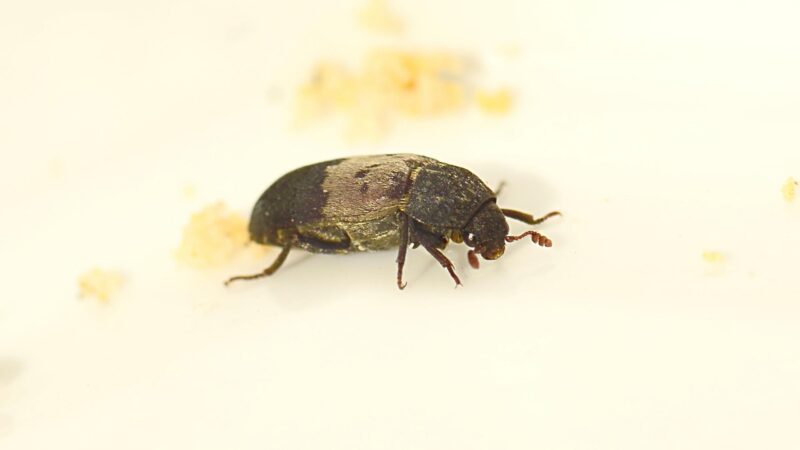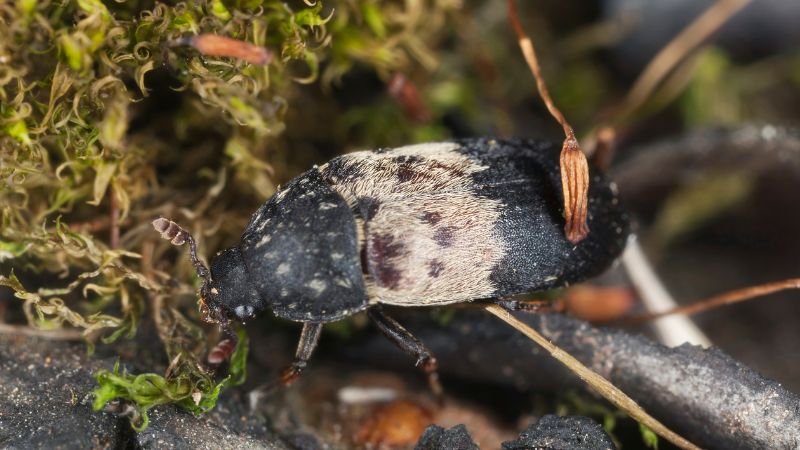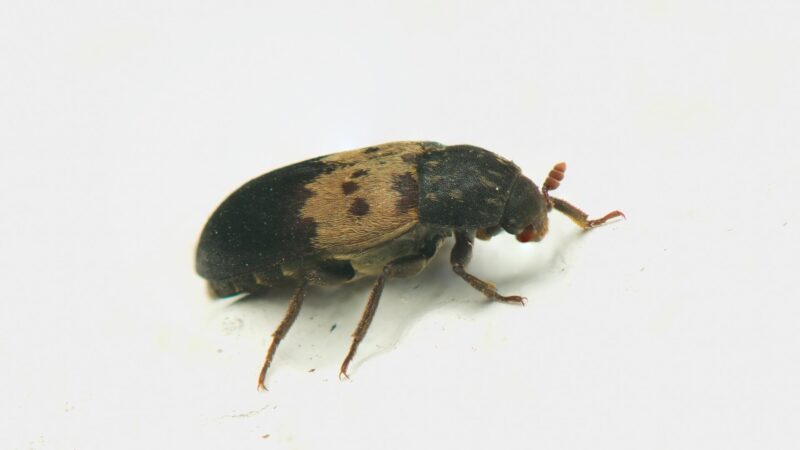Larder beetles are among the kitchen or pantry beetle species that invade stored dry food products around the world. This makes them challenging to eliminate, especially during their peak season.
Are larder beetles active in the spring? Yes, larder beetles are active in the spring. This is also their mating season, which means that an infestation may happen in the summer if they are ignored. This beetle species has only one generation a year, but they can cause severe damage to stored dry foods.
As a homeowner, you would want to prevent larder beetles from entering your house. After reading this article, you will learn everything about larder beetles and how to get rid of them effectively.
What Are Larder Beetles?

Larder beetles (Dermestes lardarius) are both household and commercial pests. As the name implies, the larder beetle feeds on a wide variety of meat products. This beetle species also eat dead animals and insects, leather goods, and other organic materials.
Larder beetles are close relatives of carpet beetles. They are widely distributed around and are commonly found in homes, museums, livestock facilities, and other places with food preparation, dry pet food, and foods with high protein content.
What Do Larder Beetles Look Like?
Adult larder beetles are black or reddish-brown and are about ⅓ inch long. The middle part of their wing covers has a pale band yellow with six dark spots. Their legs and underside of the body are covered with fine yellow hairs, while the top of their tail end has two curved spines called urogomphi.
Larder beetle larvae are usually reddish-brown to almost black, with a cigar-shaped body that is heavily covered with hair. Just like the adults, they also have a pair of spines on the last segment of their abdomen. Once they get matured, these larvae can grow between ½ and ⅝ inch long.
The Life Cycle of a Larder Beetle
Like all beetle species, larder beetles undergo complete metamorphosis. They pass through four life stages: egg, larval, pupal, and adult. Females lay more than 100 eggs on suitable food sources, especially spoiled meat, which usually hatch within 2 weeks.
Larvae will then start to feed until they mature. These larvae undergo 5-6 instar stages, which usually last for 40-50 days. Afterward, they will bore holes in wood and wooden structures where they can safely pupate.
Depending on the temperature, the pupal stage may last for 3 to 7 days only. On average, the life cycle of larder beetles is completed in 2 months.
Related: Carpet Beetle Larvae | Are They Dangerous?
What Time of the Year Larder Beetles Are Active?

Larder beetles are very active in the spring. Additionally, females will start laying eggs in the summer. During these seasons, these beetle species will live in large groups in museums and residential and commercial establishments where they attack nests of birds and rodents to eat insects.
Where Did Larder Beetles Come From?
Historically, larder beetles have been a longtime pest of cured meat products in the US, Canada, and Europe. However, their population somehow decreased when the habit of refrigeration of foods began, and people buy meat only in small quantities.
But still, these wood-boring beetles continue to infest pantry foods. As such, if you find ladder beetles inside your home, they are likely from a purchased infested food. Outdoors, these beetles can be found feeding on flower pollen or dead animals.
Once spring arrives, they will enter buildings and houses where a food source is abundant. Ladder beetles can pass through tiny crawl spaces.
What Are Larder Beetles Attracted To?
Larder beetles are very attracted to cured food, spoiled food, dry pet food, food hidden by rodents and birds, leftover rat bait, grease from cooking and food preparation, carcasses of birds, insects, and rodents, as well as animal museum specimens. Larder beetles are also attracted to bright lights, especially at night.
Why Am I Getting Larder Beetles in My House?
There are three possible reasons why there are larder beetles in your house:
- First, you may have bought dry food packages that are already infested.
- Second, your attic may have some dead rodents or insects.
- And third, your house has small cracks where larder beetles can enter, especially during spring and winter.
Do Larder Beetles Hibernate?
Ladder beetles hibernate but not necessarily the way cold-blooded animals do. Instead, they wait for winter to pass before they become as active as they normally do.
This entire process is called overwintering. Adult larder beetles overwinter in protected areas such as tree barks, wall cracks, and crevices in homes.
Does One Larder Beetle Mean Infestation?

Having one or a few adult larder beetles inside your home does not necessarily mean that there is already an infestation. These beetles may have only entered your house during peak season. But once you find them in their food source, they can easily accumulate, and infestation is very likely to happen soon.
Related: How Do You Tell if It’s a Beetle or Cockroach in Your House? | Identification and Guide
How Do You Know if You Have a Larder Beetle Infestation?
As mentioned earlier, larder beetles love to eat different kinds of dry foods, as well as dead animals. And since females deposit eggs on their food source, an infestation is very likely to happen once the eggs hatch.
Note that their larvae are also scavengers. Therefore, here are some signs of a larder beetle infestation:
- A heavy presence of adult larder beetles and larvae in the storage of dry food.
- A strong smell of dead rodents in the attic suggests that larder beetles have been infesting them.
- Packages, boxes, and containers of dry food and pet food have small holes.
- Adult larder beetles fly in and out from cracks and crevices within walls where dead insects could be present.
- The presence of beetle skin means larvae have been molting in that area.
- Tiny holes bored on wood and other solid materials, where larvae emerge to pupate. They don’t eat wood, though.
What Is the Best Way to Get Rid of Larder Beetles?
The best way to get rid of these beetles is by eliminating their food source. This includes throwing away infested food and regular cleaning of areas where rats and insects are attracted to.
For more effective cleaning, use a vacuum cleaner with a crevice tool such as the following product:
- LIFT-AWAY FUNCTIONALITY: lift away the detachable pod and easily...
- ANTI-ALLERGEN COMPLETE SEAL TECHNOLOGY: Works with a HEPA filter...
- POWERFUL & LIGHTWEIGHT : Powerful suction to deep-clean carpets...
- BRUSHROLL SHUTOFF: Feature allows you to instantly switch from...
- SWIVEL STEERING: Easily maneuver your vacuum in and out of tight...
If there are food packages that are already heavily infested with larder beetles, throw them away. If there are only a few beetles, remove them one by one by hand. Alternatively, freeze the containers at 0°F for 24 hours or more. You may also heat them in an oven at 125 to 140°F for about 30 minutes.
How to Avoid Larder Beetles From Emerging in Spring?
Again, spring is when larder beetles are most active. It is also during this season that they mate, reproduce, and are very likely to enter your house. In most cases, these beetles may have just emerged from hibernation.
To avoid them from emerging, especially in the spring, here are some things you can easily do:
- Inspect food items carefully before buying them. Don’t buy items with damaged packages.
- Avoid buying pet food in large quantities, and place unused food in insect-proof containers.
- Store all human and dry pet food products in airtight plastic, metal, or glass containers.
- If you are using mouse traps, check them regularly and dispose of dead rats as soon as possible. Vacuum and sanitize the area.
- If you have a birdhouse, don’t place it near your house and clean it regularly.
- Always clear your lighting and window sill of dead insects.
- If you are using a bagged vacuum cleaner for getting rid of larder beetles and other insects, empty the bag or throw them away outside your house.
- Seal all cracks and crevices on walls, and replace damaged window screens.
- Insulate your doors and windows using reliable weather stripping such as Mikosi 3M Silicone Sealing Tape .
- 【8 Meter Weather Stripping for Doors】MIKOSI 26 Feet Door Seal...
- 【Widely Application】 Weather stripping door seal strip for...
- 【Installation is Quick and Easy】Before using the door weather...
- 【No Bug,Weatherproof & Soundproof】The door seal strip can be...
- 【Energy Efficient & Noise Reduction】Weather stripping door...
- If you notice some adult larder beetles emerging from their hiding places, place glue traps with pheromones such as Trap A Pantry Moth Traps .
- Pantry Moths Only- These do not work for Clothes Moths or Gypsy...
- Easy To Use- Simply peel back the paper exposing the glue, then...
- Keep Food Safe- Protects Yourself from moths that eat grains,...
- Great Design- Our beautiful design will blend right into your...
- The Trap A Pest Promise - If for any reason you're not completely...
Related: How to Get Rid of Japanese Beetles Naturally? | Identification and Control Guide
Does Cold Kill Larder Beetles?
Cold can kill larder beetles, which is why they overwinter in buildings and homes. In fact, placing an infested food package in a freezer at 0°F for at least 24 hours can kill all life stages of larder beetles. Nonetheless, they can survive winter by going into a state of diapause or suspended development.
List of Sources
Hahn, J., Kells, S. (2019). Larder beetles.
Jacobs, S. (2013). Larder Beetle.
Klass, C. (2009). Larder Beetle Dermestes lardarius L.
Lewis, D. (1994). Larder Beetles are Active in the Spring.
Pellitteri, P. (2004). Larder Beetles.
- Bed Bug Surge 2025: How to Detect, Prevent, and Safely Eliminate Infestations in Top U.S. Cities - June 18, 2025
- Asian Needle Ants Invade US Homes: 2025 Guide to Identification, Risks, and Effective Control - June 11, 2025
- New World Screwworm Alert: How US Livestock Owners Can Prevent Outbreaks and Protect Herds [Summer 2025 Update] - June 8, 2025



